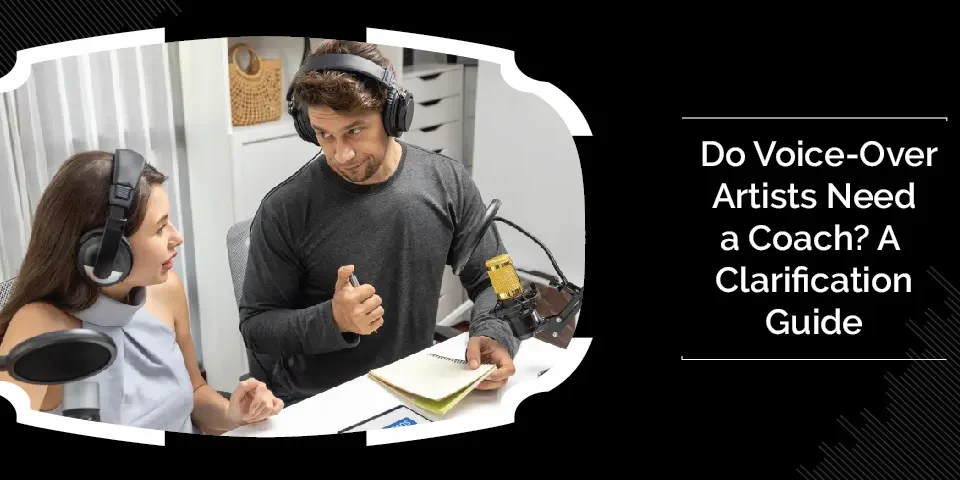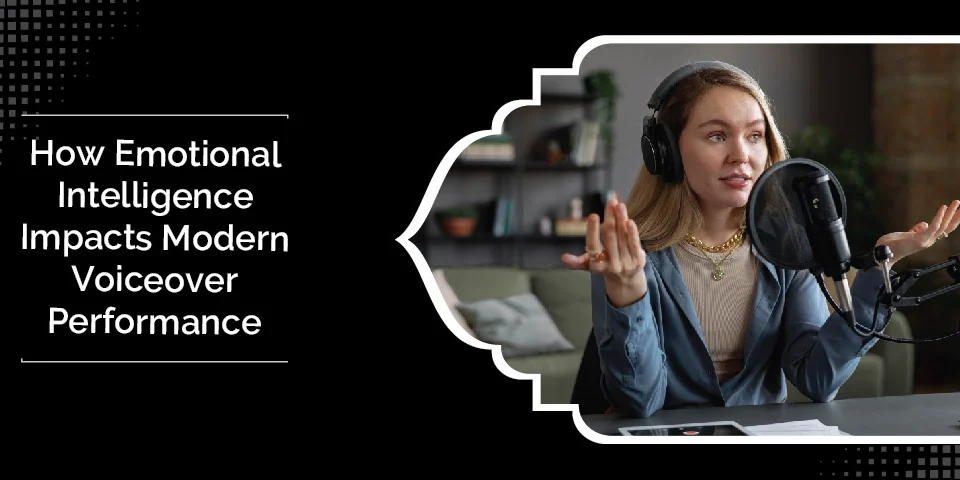
Voice Over Marketing: The Key To Creating Lasting Impressions
June 21, 2023
6 Important Reasons For Using Voice Overs For Videos
July 24, 2023Exploring different voice-over genres can help aspiring voice-over artists expand their skills and knowledge, helping them master the art of storytelling. It can also help people understand and appreciate the storytelling process. And in order to understand the different genres of voice-over work, it is essential to grasp the essence of voice-over work. Voice-over work involves recording dialogue or narration for films, TV shows, commercials, video games, and audiobooks. It involves voice-over artists giving voice to characters, presenting information, or improving storytelling.
Voice-over artists are essential to the media and entertainment sectors because they may voice characters, explain concepts, instruct, and inform audiences.
- In movies and TV shows, voice-over narration helps viewers understand characters’ motivations and feelings. Same is true for voice-over in TV Commercials.
- Video game avatars come alive with voice actors.
- Voice-overs are crucial for audio novels, because narrators engage listeners with their voices and interpretations.
Voice-over artists have a variety of options to choose from across various media platforms. Animation studios, advertising agencies, production businesses, game companies, and e-learning platforms hire voice-over artists. You would be glad to know that agencies that specialise in creating podcasts, audiobooks, streaming services, and virtual reality have boosted demand for qualified voice performers. Globalisation creates chances for multilingual voice performers.
Furthermore, technology has given voice-over artists the opportunity to directly contact customers and studios, making it possible for them to work remotely. The chance to work remotely has made voice-over work a coveted, versatile and creative option for performers and storytellers.
Contents
A] Understanding The Different Voice-Over Genres
1. Commercial Voice-Over
Advertisements on TV, radio, or the internet use voice talent to promote and build brand awareness. Commercial voice-overs use spoken dialogue, sound effects, and music to engage viewers.
Good commercial voice-over artists can modify their voices to match the message. They should be able to portray several characters or brand personas. Commercial voice-overs require a good storyline, timing, and direction. This industry values professionalism, reliability, and deadline-oriented work.
What skills should a commercial voice-over actor possess?
- Commercial voice-over artists should use a conversational and relatable tone.
- They should emphasise selling elements, use a suitable tempo, and show excitement or emotion.
- Furthermore, the timing and rhythm also keep audiences interested.
- Voice actors should also focus on pronunciation, enunciation, and intelligibility.
2. Character Voice-Over
Character voice-over involves voicing animated or fictional characters in movies, TV, video games, and cartoons. It requires voicing characters with distinct personalities, attributes, and emotions.
Character voice-over artists voice superheroes, villains, animals, and fantasy creatures. Mickey Mouse, Chota Bheem, and the Joker from Batman are some of the popular examples.
What skills should a character voice-over actor possess?
- Character voice-over actors must study the character’s past, traits, and motives to create a voice that matches their personality.
- Different dialects, tones, pitches, and speaking patterns can generate unique voices.
- Voice-only acting requires improvisation and emotional expressiveness.
- Character voice-overs require vocal range and flexibility. Wide-ranging actors can play roles with deep, frightening voices or high-pitched, exuberant ones.
Flexibility lets them sing in many voice-over styles, genres, and ages. It helps actors build memorable characters that enhance storytelling.
3. Narration Voice-Over
Narration voice-over involves the delivery of spoken narration to guide the audience through a story, provide information, or set the mood in various forms of media, such as documentaries, films, audiobook voice over, and instructional videos.
What skills should a narration voice-over actor possess?
- Actors should use passionate and emotional delivery to hook audiences.
- To create interest and tension, the voice should change with the story’s ups and downs.
- Vocal pauses, word emphasis, and smart pacing can improve story flow and audience engagement.
- The content’s tone—authoritative, conversational, dramatic, or intimate—should match. It creates the desired mood and audience response. Tone and cadence improve narrative impact and message delivery.
4. Audio Books and E-Learning Voice-Over
Audio book voice-over involves narrating books or other written content to be consumed in an audio format. E-learning voice-over involves delivering instructional content for online courses, training modules, and educational materials. The goal is to engage and educate learners effectively.
The art of engaging and educating audiences through audio books requires voice actors to bring characters to life, create immersive experiences, and maintain listeners’ attention throughout the narration.
What skills should an audio book and e-learning voice-over actor possess?
- They must employ effective pacing, use appropriate emotions, and employ different voices for characters, enhancing the story’s impact and keeping the audience captivated.
- Voice actors in e-learning must use a clear and confident tone, using appropriate intonation and emphasis to highlight key information.
- Clarity and pronunciation are crucial to ensure learners understand and retain the content.
A well-executed e-learning voice-over facilitates effective learning, enhances comprehension, and keeps learners motivated and engaged throughout the educational experience.
B] Exploring Voice-Over Genres in Different Industries
1. Animation and Gaming
In the course of discovering different types of voice-over work, the animation and gaming industry immediately comes to mind. Of the various types of voice-over work, this one requires specific techniques to bring animated characters and video game personas to life.
How do the voice actors in Animation and Gaming make the performances memorable and interesting?
- Characters, backgrounds, and emotions shape their voices. Actors must connect with the character and understand their motivations to be authentic.
- They may use physicality and facial emotions to improve vocal delivery, affecting the character’s animation.
- In gaming, actors often record multiple variations of lines to accommodate different player choices or outcomes, ensuring a seamless experience.
- Expressiveness expresses character emotions and aids storytelling in animation and gaming voice-overs.
- To produce a convincing and compelling experience, actors must convey several emotions, from joy and enthusiasm to grief and fury.
This genuineness draws viewers into the animation or game and creates an emotional connection. Voice actors who are expressive and honest give characters depth and realism, improving the viewing and playing experience.
Read: Video game voice over guide
2. Advertising and Marketing
The role of voice-over in advertising and marketing is instrumental in creating impactful and memorable campaigns. Advertising and marketing voice-over uses different methods based on the goal. Voice actors use their voices to persuade, captivate, and leave a lasting impact in ads.
How do the voice actors in Animation and Gaming make the ads memorable and engaging?
- Professional voice over artists use enthusiasm, mystery, and storytelling to enhance interest in promotional videos and trailers. Jingles and catchy tunes rely on voice-overs to create memorable melodies.
- Memorable advertising demands careful consideration of many variables. A strong voice and well-written script can leave an impression.
- Voice-over tone, tempo, and emphasis should match the brand’s image and message.
- To make an effective ad, the voice-over should match the graphics and music. Consistency and repetition can help make the voice-over memorable.
An effective voice over for advertising and marketing can stir emotions, grab attention, and make a lasting impression on customers, boosting brand identification and sales.
3. Film and Television
The role of voice-over in film and television is significant in enhancing storytelling and delivering important information to the audience.
Film and TV voice-over techniques vary:
- Voice actors use dramatic and fascinating deliveries in film trailers to promote anticipation and excitement.
- In documentaries, the voice-over provides background, observations, and narration. Voice-overs can introduce characters, set the scene, or provide interior monologues in TV shows, enriching the tale.
Film and TV voice-overs enhance visual narrative. It adds depth, emotion, and perspective to imagery. Voice-overs can convey background information, character motivations, or suspense. They can also bridge time or place, ease transitions, or offer a narrative structure. Voice-over enriches storytelling, allowing filmmakers and showrunners to create immersive and compelling experiences.
4. Corporate and Training
Voice-over in corporate and training programmes delivers the information, engages, and projects professionalism. Corporate and training voice-overs emphasise clarity.
Corporate videos and presentations use confident, authoritative voice actors to deliver critical messages, sell products or services, or provide company information. Voice-over artists use a conversational style to explain topics and provide step-by-step directions in training programmes. Pacing, intensity, and intonation are optimised for comprehension and recall.
Voice actors must precisely pronounce every syllable. Professionalism instils confidence and credibility in the material. Understanding and engagement depend on clear pronunciation, enunciation, and tempo. A well-done voice-over in corporate and training materials lends authority, improves learning, and helps audiences retain knowledge.
C] How to Get Started in Voice-Over Work
Getting started in voice-over work requires a combination of training, networking, and building a strong portfolio. Here are some essential steps to get you started on a voice-over career:
1. Education and Training
To hone your abilities, think about signing up for voice-over courses or programmes. These programmes can offer direction in terms of vocal technique, screenplay interpretation, and business expertise. Additionally, work on your diction, experiment with various voice timbres, and read aloud.
2. Identifying Opportunities
Look for chances to learn and be exposed. Start by putting in voice-over auditions for regional theatre plays, student films, or charitable organisations. Investigate voice-over-related online communities and websites where you can locate job openings, tryout possibilities, and connections to pros in the field.
3. Creating a Portfolio and Demo Reel
Put together a portfolio and demo reel that highlight your range and versatility as a voice-over artist. Samples of all, voice-over styles, genres, and character voices should be included. To draw in potential customers, your demo reel should be succinct and feature your best performances inside the first few seconds.
4. Tips for Success
- Create a distinct vocal identity by identifying your voice and bringing a new viewpoint to your performances.
- Join voice-over communities, attend industry events, and interact with other professionals to broaden your network.
- Maintain professionalism by meeting deadlines, communicating clearly with clients, and continuously producing high-quality work.
- Improve your abilities constantly by practising frequently, keeping up with industry developments, and getting feedback on your work.
- Always keep in mind that it takes time and persistence to succeed in the voice-over industry. You may improve your chances of success in the cutthroat world of voice-over work by making an investment in your education, aggressively looking for possibilities, and developing a good portfolio.
If you are someone who is looking to become a professional voice over artist, you can read our informative voice over guide!
Conclusion
Voice-over work encompasses various genres, each requiring distinct skills and approaches. An artist can dabble in one or several different voiceover specialties From commercial to animation to Corporate work or projects in Film, Television and video games. Each genre requires specific techniques, versatility, and adaptability to effectively convey messages, emotions, and characters through voice alone.
If you are looking for a voice over artist for audiobooks or any of the above genre’s, don’t hesitate to contact me!

Peter Abraham
Peter Abraham is a versatile voice-over artist based in Mumbai working in the voiceover industry since 2009. With a passion for storytelling and meticulous attention to detail in every project, he brings scripts to life with his captivating voice and professional delivery, exceeding client expectations. Whether it's a commercial or an audiobook, Peter specializes in a wide range of voice-over work, ensuring the highest quality.




